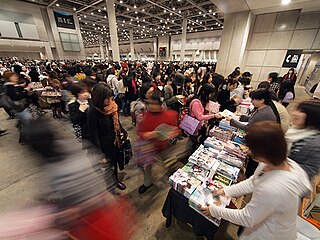
Anime is hand-drawn and computer-generated animation originating from Japan. Outside Japan and in English, anime refers specifically to animation produced in Japan. However, in Japan and in Japanese, anime describes all animated works, regardless of style or origin. Many works of animation with a similar style to Japanese animation are also produced outside Japan. Video games sometimes also feature themes and artstyles that can be considered as "anime".

Manga are comics or graphic novels originating from Japan. Most manga conform to a style developed in Japan in the late 19th century, and the form has a long history in earlier Japanese art. The term manga is used in Japan to refer to both comics and cartooning. Outside of Japan, the word is typically used to refer to comics originally published in the country.

Otaku is a Japanese word that describes people with consuming interests, particularly in anime, manga, video games, or computers. Its contemporary use originated with a 1983 essay by Akio Nakamori in Manga Burikko.

In Japan, doujin is a group of people who share an interest, activity, or hobby. The word is sometimes translated into English as "clique", "fandom", "coterie", "society", or "circle". Self-published creative works produced by these groups are also called doujin, including manga, magazines, novels, music, anime, and video games. Print doujin works are collectively called doujinshi.

Manhwa is the general Korean term for comics and print-cartoons. Outside Korea, the term usually refers to South Korean comics. Manhwa is directly influenced by Japanese Manga comics. Modern Manhwa has extended its reach to many other countries. These comics have branched outside of Korea by access of Webtoons and have created an impact that has resulted in some movie and television show adaptations.
Manhua are Chinese-language comics produced in Greater China. Chinese comics and narrated illustrations have existed in China throughout its history.
Digital comics are comics released digitally, as opposed to in print. Digital comics commonly take the form of mobile comics. Webcomics may also fall under the "digital comics" umbrella.
Chinese animation refers to animation made in China. In Chinese, donghua describes all animated works, regardless of style or origin. However, outside of China and in English, donghua is colloquial for Chinese animation and refers specifically to animation produced in China.

Webtoons (Korean: 웹툰) are a type of digital comic that originated in South Korea usually meant to be read on smartphones.
Hong Kong comics are comics originally produced in Hong Kong.
There is significant awareness of Japanese popular culture in the United States. The flow of Japanese animation, fashion, films, manga comics, martial arts, television shows and video games to the United States has increased American awareness of Japanese pop culture, which has had a significant influence on American pop culture, including sequential media and entertainment into the 21st century.

Cool Japan refers to the aspects of Japanese culture that non-Japanese people perceive as "cool". The Cool Japan strategy is part of Japan's overall brand strategy, aiming to disseminate Japan's attractiveness and allure to the world. The target of Cool Japan "encompasses everything from games, manga, anime, and other forms of content, fashion, commercial products, Japanese cuisine, and traditional culture to robots, eco-friendly technologies, and other high-tech industrial products".
Manga (漫画) are comics created in Japan, or by Japanese creators in the Japanese language, conforming to a style developed in Japan in the late 19th century. The term is also now used for a variety of other works in the style of or influenced by the Japanese comics. The production of manga in many forms remains extremely prolific, so a single list covering all the notable works would not be a useful document. Accordingly, coverage is divided into the many related lists below.
Little Cherry is a Chinese media franchise created by Yang Shangjun. Owned by the Zhengzhou-based Zhengzhou Little Cherry Cartoon Art Co., it is primarily comedy manhua featuring a girl whose name is Little Cherry. It is titled Xoyto in English.
ACG is a term used in some subcultures of Greater China and East Asia. Because there is a strong economic and cultural interlinkage that exists between anime, manga, and games in Japanese and East Asian culture at large, the term ACG is used to describe this phenomenon in relative fields. The term refers in particular to Japanese anime, manga, and video games. The term is not normally translated into Chinese; if the meaning needs to be translated, it is usually "動漫遊戲", "two-dimensional space", or "動漫遊".

Alpha Group Co., Ltd. is a Chinese multinational conglomerate with animation, toy, mass media asset and entertainment company headquartered created by Cai Dongqing in 1993. In 2016, it changed name from Alpha Animation. The company has a Chinese webcomics site, U17, and also an American film company, Alpha Pictures, and has announced the creation of an animation division also based in the United States.

Ultramarine Magmell is a Chinese manhua series written and illustrated by Dainenbyo. A Japanese anime television series adaptation by Studio Signpost aired from April 7 to June 30, 2019.
MyAnimeList, often abbreviated as MAL, is an anime and manga social networking and social cataloging application website run by volunteers. The site provides its users with a list-like system to organize and score anime and manga. It facilitates finding users who share similar tastes and provides a large database on anime and manga. As of January 2023, the site reported having approximately 23,000 anime and 62,000 manga entries. In 2015, the site received 120 million visitors a month.

The King's Avatar is a Chinese donghua web series aired in 2017, based on the web novel of the same name written by Hu Die lan. The series depicted the fictional esports scene in China where the story revolves around a multiplayer online video game called Glory. The series was produced by Chinese internet company Tencent. A 3-episode sequel premiered in 2018, and a long delayed second season aired in 2020. A prequel film, titled The King's Avatar: For the Glory, had a 2019 release.

Biao Ren or Hyoujin: Blades of the Guardians (镖人) also known as Blades of the Guardians, is a Chinese manhua that was written and illustrated by Xianzhe Xu. It was first serialized in the new comics app in July 2015. The manhua quickly attracted a large number of readers and was well received. Since its first publication, Biao Ren has been serialized on online platforms including Tencent Comics. As of March 2022, Beijing United Publishing Company has released eleven tankōbon volumes.









